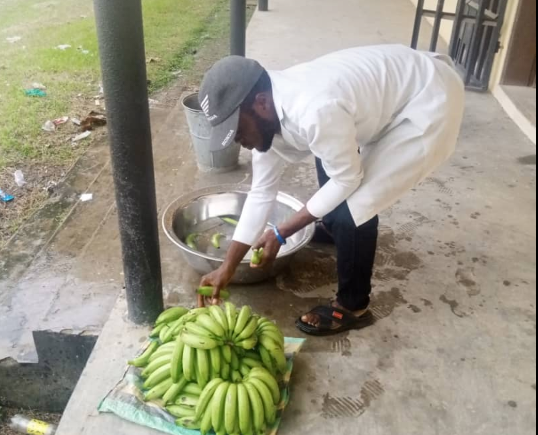Hello and happy new months to a steemians, what a wonderful period to be alive.
i'm Edet Asuquo, a graduate from the department of food science and technology. Part of my final year research was to evaluate the human risk assesment of artificial ripened fruit (banana).

- Me cleaning and sorting banana prior to my research and analysis
it is believed that he that gives food, gives life as we can't do without food, as it is food first, other necessities second.
Recently, the link between food intake and health has been proven important to a great extent in scientific exploration to identify the particular plant component that express health benefits.
Food contamination through poisons is on the increase in Nigeria according to Ali
Fruits (Banana) are widely distributed in nature, commercially important and nutritionally indispensable food commodities. They are an essential component in the human daily diet as they depend on this fruits(banana) as a source of nutients such as vitamins, minerals, fibre, antioxidant and phytonutrients.
Banana is a climacteric fruit (are characterized by transient increase in both ethylene synthesis and respiration at an early stage of ripening. They include avocado, banana, cherimoya, mango, kiwifruits, apple, apricot, jackfruit, papaya, peach, pear, and tomato etc ), it is usually eaten as a supplementary food or as a whole meal. According to the Food and Agricultural Organisation (FAO), banana is the 4th most important global food commodity after rice, wheat and maize. Banana is rich in vitamin A and C, carbohydrates, mineral element such as phosphorus, selenium, potassium, magnesium, and iron.

- Cleaned banana fingers ready for artificial ripening
Ripening is a natural physiological process that makes the fruit sweeter, more palatable , edible, nutritious, softer and attractive.
fruits can be ripened using artificial ripening methods. Artificial ripening is done to achieve a faster and uniform ripening. It is the process by which ripening is controlled. It accelerate the ripening process but affect the nutritional quality, quality and safety of the food.
In Nigeria, fruit vendors covertly ripen banana fruits in encased vessels where an enormous amount of calcium carbide is added and sprinkled with water before concealing such vessels. This triggers the
arrival of acetylene for ripening procedure in fruits, an inflammable gas including the danger of fire perils. This method is dangerous given the fact that Calcium carbide(CaC2) contains arsenic hydride and phosphorus hydride impurities, and also given the fact that these traders just simply add CaC2 into ripening vessels without recourse to concentrations required for safer outcomes. Other ripening procedures include bagging. Bagging strategy ensures and upgrades the visual nature of fruit by advancing skin coloration and diminishing blemishes, however, changes the miniaturized scale condition for fruit advancement, which can have various valuable impacts on inward fruit quality. The disadvantage associated with bagging include diminished fruit size and weight due to low light transmittance of
the bags and this discourages several vendors from indulgence in this method. This, therefore, leaves the use of carbide as the most commonly used method for induced fruit ripening. Compared to other common fruit ripening methods adopted by fruit vendors in Nigeria, to what extent is the reliance on CaC2 effective for ripening? Based on the availability of impurities in CaC2, is the accumulation of arsenic in the CaC2 ripened fruit endocarp possible? The outcome of this study will contribute to creating awareness about the implications of traditional fruit ripening methods on fruit quality and value.
Types of Artificial ripening agent/methods.
There are two types of ripening agent according to research which are:
- Biological ripening agents: it is the use of biological material (mostly from plants) to accelerate ripening. e.g mango, African bush mango(ogbono), paw-paw leaves, apples etc. According to research it has been shown that using biological ripening agents is safe.
- Chemical ripening agents: it is the use of chemical to increase the ripening rate. e.g calcium carbide, potash, wood ash, ethephon, detergents, polyethene bag, hot water, Ethylene glycol, kerosene.
Ripening agents and possible health hazards
According to research, some of the health hazard associated with some ripening methods are summarize below.
| Ripening agent | Possible health hazard |
|---|---|
| calcium carbide | diarrhea,vomitting,irritation or burning of the eyes and skin, permanent eye damage etc |
| ethylene glycol | renal failure |
| kerosene | pulmonary injuries |
Ban on using Calcium Carbide
Considering its hazardous effects, Calcium Carbide is banned in many countries including Nigeria, but despite the ban, it is widely used. In order to protect citizens' lives, the National Agency for Food and Drug Administration and Control (NAFDAC) has cautioned Nigerians, particularly fruit vendors, to refrain from applying calcium carbide to ripened fruits for commercial purposes.
source
How do you tell whether a fruit has been artificially ripened
Fruits that appear appealing on the outside may be harmful to one's health. Fruits with a consistent color have most likely been artificially ripened. The naturally matured fruits are spotty rather than uniformly colored.
Conclusion
Artificial fruit ripening is a difficult issue, particularly in developing nations like Nigeria, and involves the participation of the entire community, including government agencies, policymakers, fruit vendors, farmers, scientists, and consumers, to discover an effective solution.
Thank you for reading